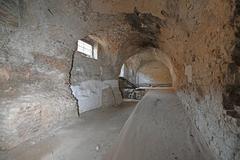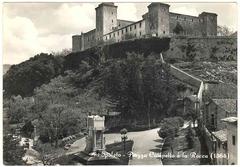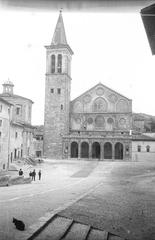Tempio Romano Visiting Hours, Tickets, and Historical Sites in Spoleto, Italy
Date: 14/06/2025
Introduction: The Tempio Romano and Its Significance in Spoleto
The Tempio Romano in Spoleto stands as a remarkable monument to the city’s Roman heritage and architectural prowess. Located in the heart of Umbria, this ancient temple, dating back to the 1st century BCE, offers an immersive window into the daily life, religion, and civic traditions of Roman Italy. Closely linked to the nearby Roman Theatre and other archaeological treasures, the Tempio Romano reflects Spoleto’s status as a crucial stop along the ancient Via Flaminia, the famous Roman road connecting Rome to the Adriatic Sea. The temple’s enduring presence, with its Corinthian capitals and travertine stonework, exemplifies the city’s layered history, where Roman, medieval, and Renaissance elements converge.
Visitors to the Tempio Romano can admire its preserved columns, podium fragments, and adjacent structures that have been integrated into later buildings, gaining insight into the evolution of Spoleto’s urban and sacred landscape. Beyond its religious role, the temple functioned as a civic center, symbolizing continuity from antiquity to the present. Today, the site is a vibrant cultural landmark, often featuring events during the renowned Festival dei Due Mondi, which connects contemporary audiences to Spoleto’s ancient roots.
This guide provides essential information for travelers—visiting hours, ticketing, accessibility, and tips for maximizing your experience. It also highlights other notable attractions, such as the Roman Theatre, Arch of Drusus and Germanicus, and the National Archaeological Museum, for a comprehensive exploration of Spoleto’s historical landscape. Whether you are passionate about history, architecture, or culture, the Tempio Romano offers an enriching journey through time. For further details, consult resources like Live the World, Strictly Italy, and the Museo Archeologico Nazionale di Spoleto.
Table of Contents
- Introduction
- Architectural Layout and Features
- Artistic Elements and Decorative Details
- Layered History and Adaptive Reuse
- Restoration and Modern Uses
- Visiting Information: Hours, Tickets, and Accessibility
- Getting There and Nearby Attractions
- Frequently Asked Questions (FAQs)
- Media and Visual Suggestions
- Conclusion
- References and Further Reading
Architectural Layout and Features
Constructed in the 1st century BCE, the Tempio Romano exemplifies Roman engineering and urban planning (Live the World). The semicircular cavea (auditorium) spans approximately 114 meters in diameter and could seat thousands of spectators. Architectural highlights include concentric corridors, barrel-vaulted passageways, and the orchestra—an area once adorned with colorful marble slabs from across the empire.
The original stage building (scaenae frons) featured elaborate columns and decorative reliefs, though much was lost or repurposed in later centuries, especially with the construction of the Church of Sant’Agata atop the ruins. The lower levels remain well-preserved, showcasing original Roman masonry, while the upper sections were significantly altered during medieval adaptations (Strictly Italy).
Artistic Elements and Decorative Details
Excavations have uncovered precious artistic remnants, such as sculptures and portraits of Roman emperors Augustus and Julius Caesar—now housed in the National Archaeological Museum nearby (Strictly Italy). The use of imported marbles and mosaics reflects the city’s cosmopolitan character during the Roman period.
Although much of the original decoration has vanished, surviving fragments offer glimpses into the artistic tastes and technical skills of ancient craftsmen (Live the World).
Layered History and Adaptive Reuse
After the decline of the Roman Empire, the theatre’s stones were quarried for new buildings. In the 12th century, the Church of Sant’Agata was erected atop the site, integrating the ancient structure into the medieval cityscape (Live the World). Over time, the theatre served as a prison, a monastic cloister, and part of the Corvi family’s palace, illustrating the palimpsest of Roman, medieval, and Renaissance layers that define Spoleto’s urban identity (Strictly Italy).
Restoration and Modern Uses
Restoration began in the late 19th century, led by archaeologist Giuseppe Sordini, revealing the theatre’s full extent beneath later structures (Strictly Italy). Today, the site is a dynamic venue for public performances, particularly during the Festival dei Due Mondi, hosting concerts, dance, and theater events that echo its ancient function (Live the World).
Visiting Information: Hours, Tickets, and Accessibility
Visiting Hours
The Tempio Romano is generally open year-round from 9:00 AM to 7:00 PM, with seasonal variations and potential changes during major events like the Festival dei Due Mondi. Always verify current hours before your visit.
Tickets
Tickets are available onsite and online. Admission often includes access to the National Archaeological Museum. The Spoleto Card provides combined entry to several city attractions (Strictly Italy).
Accessibility
While the site is generally accessible, some uneven surfaces and ancient stairways may pose challenges for visitors with mobility issues. Contact the site or museum in advance for specific accommodations.
Guided Tours and Visitor Tips
Guided tours (in multiple languages) are highly recommended for a deeper understanding of the site’s history and architecture. The theatre is close to Piazza della Libertà and easily reached on foot from the historic center.
For a unique experience, visit during the Festival dei Due Mondi for live performances, or explore in quieter months for a contemplative atmosphere. Photography is permitted; the lower cavea offers prime views of Roman construction techniques.
Getting There and Nearby Attractions
Getting There
The Tempio Romano is centrally located and within walking distance from Spoleto’s main transport hubs. Parking is available near Piazza della Libertà if you arrive by car (Italy Heaven).
Nearby Attractions
Don’t miss the Spoleto Cathedral, Casa Romana, Torre dell’Olio, remnants of the Via Flaminia, and the Arco di Druso (Wanderlog). These sites provide a comprehensive journey through Spoleto’s historic and artistic evolution.
Frequently Asked Questions (FAQs)
Q: What are the Tempio Romano visiting hours?
A: Generally from 9:00 AM to 7:00 PM, but check for seasonal changes and special events.
Q: How can I purchase tickets?
A: Tickets are available onsite and online, with combined options like the Spoleto Card.
Q: Is the site accessible for people with mobility issues?
A: Some areas may be challenging due to uneven surfaces, but accessibility is improving. Contact the museum for details.
Q: Are guided tours available?
A: Yes, and highly recommended for a richer experience.
Q: When is the best time to visit?
A: Early morning or late afternoon to avoid crowds and heat, especially during the busy festival season.
Q: Can I take photographs?
A: Yes, photography is allowed, but professional equipment may require permission.
Media and Visual Suggestions
Alt text: Tempio Romano Roman columns and ancient stone architecture in Spoleto.
Conclusion
A visit to the Tempio Romano in Spoleto is an invitation to step into a living history where Roman, medieval, and modern influences converge. The site’s preserved architecture, rich artistic legacy, and ongoing cultural relevance—especially during the Festival dei Due Mondi—make it a highlight of any trip to Umbria. By planning your visit with up-to-date information on hours, tickets, and accessibility, and by combining your tour with other local attractions, you’ll enjoy a rewarding and memorable experience.
Be sure to download the Audiala app for audio guides and the latest visitor information. For further reading and practical resources, consult the references below.
References and Further Reading
- Live the World, 2025, Tempio Romano Spoleto: A Visitor’s Guide
- Strictly Italy, 2025, Things to Do in Spoleto
- Museo Archeologico Nazionale di Spoleto, 2025, Official Site
- Wikipedia, 2025, Arco di Druso e Germanico
- Wikipedia, 2025, Casa Romana (Spoleto)
- Festival dei Due Mondi, 2025, Official Site
- Italy Heaven, 2025, Spoleto Travel Guide
- Wanderlog, 2025, Spoleto Skyline and Attractions
- MominItaly, 2025, Italy in June Travel Tips
- Essence Festival Info, 2025, Spoleto Festival 2025
- Visit Sights, 2025, Spoleto Attractions


